The acceleration of a particle in SHM is
1. Always zero
2. Always constant
3. Maximum at the extreme position
4. Maximum at the equilibrium position
सरल आवर्त गति में किसी कण का त्वरण:
1. सदैव शून्य होता है
2. सदैव नियत रहता है
3. चरम स्थिति पर अधिकतम होता है
4. संतुलन की स्थिति में अधिकतम होता है
A spring-block system is brought from the earth's surface to deep inside mine. Its period of oscillation will:
1. Increase
2. Decrease
3. Remain the same
4. May increase or decrease depending on the mass of the block
एक स्प्रिंग-गुटका निकाय को पृथ्वी की सतह से खदान की गहराई में ले जाया जाता है। इसका दोलन काल किस प्रकार प्रभावित होगा?
1. बढ़ेगा
2. घटेगा
3. अपरिवर्तित रहेगा।
4. गुटके के द्रव्यमान के आधार पर बढ़ या घट सकता है।
A simple pendulum attached to the ceiling of a stationary lift has a time period of 1 s. The distance y covered by the lift moving downward varies with time as y = 3.75 , where y in meter and t in second. If g = 10 , then the time period of the pendulum will be
1. 4 s
2. 6 s
3. 2 s
4. 12 s
एक सरल लोलक स्थिर लिफ्ट की छत से जुड़ा हुआ है, जिसका आवर्तकाल 1s है। नीचे की ओर गतिमान लिफ्ट द्वारा तय की गई दूरी y समय के साथ y = 3.75 के रूप में परिवर्तित होती है, जहां y मीटर में है और t सेकेंड में है। यदि g = 10 , तब लोलक का आवर्तकाल कितना होगा?
1. 4 s
2. 6 s
3. 2 s
4. 12 s
A particle is performing S.H.M. with a time period 8 s and starts from the origin. The ratio of distance travelled by a particle in 1st second and 2nd second of its motion is :
1.
2. ( + 1)
3. ( - 1)
4. 2
एक कण 8s आवर्तकाल के साथ सरल आवर्त गति कर रहा है और मूल-बिंदु से प्रारम्भ होता है। इसकी गति के 1 सेकेंड और 2 सेकेंड में कण द्वारा तय की गई दूरी का अनुपात ज्ञात कीजिए:
1.
2. ( + 1)
3. ( - 1)
4. 2
The displacement of a body performing simple harmonic motion is represented by . After what approximate time from t = 0, the speed of the particle becomes maximum for the first time?
1. 0.12 s
2. 0.24 s
3. 0.33 s
4. 0.42 s
सरल आवर्त गति कर रहे पिंड के विस्थापन को द्वारा व्यक्त किया गया है। t = 0 से कितने अनुमानित समय के पश्चात, कण की गति पहली बार अधिकतम हो जाती है?
1. 0.12 s
2. 0.24 s
3. 0.33 s
4. 0.42 s
A simple pendulum is pushed slightly from its equilibrium towards left and then set free to execute S.H.M. Select correct graph between its velocity(V) and displacement (x).
1. 
2. 
3. 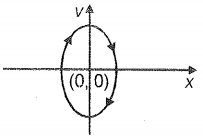
4. 
एक सरल लोलक को इसकी सन्तुलनावस्था से बाईं ओर थोड़ा धकेला जाता है और फिर सरल आवर्त गति करने के लिए मुक्त किया जाता है। इसके वेग (V) और विस्थापन (x) के मध्य सही ग्राफ का चयन कीजिए।
1. 
2. 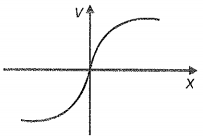
3. 
4. 
A particle moves on a circular path with uniform speed about the origin. The x-t graph will be (x : value of x-coordinate; t-time)
1. 
2. 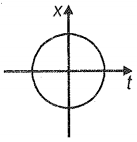
3. 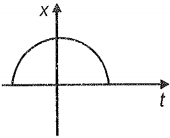
4. 
एक कण वृतीय पथ पर मूल-बिंदु के परितः एकसमान चाल से गति करता है। x-t ग्राफ कैसा होगा? (x: x-निर्देशांक का मान; t-समय)
1. 
2. 
3. 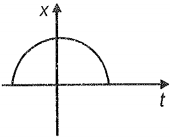
4. 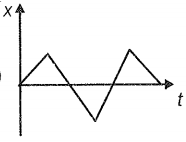
A general graph showing variation in potential energy (PE) of a particle with time while executing S.H.M. is
1. 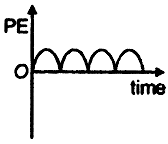
2. 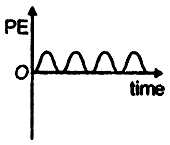
3. 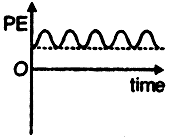
4. 
एक सामान्य ग्राफ सरल आवर्त गति करते हुए कण की स्थितिज ऊर्जा में समय के साथ परिवर्तन को प्रदर्शित करता है:
1. 
2. 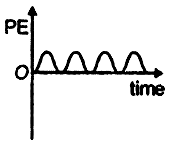
3. 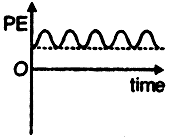
4. 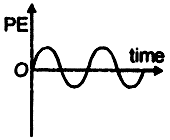
A particle is executing linear S.H.M. between x = A. The time taken to go from 0 to A/2 is and to go from A/2 to A is , then
1.
2.
3.
4.
एक कण x = A के बीच रेखीय सरल आवर्त गति कर रहा है। 0 से A/2 तक जाने का समय है और A/2 से A तक जाने का समय है, तब
1.
2.
3.
4.
A body at the end of a spring executes S.H.M. with a period while the corresponding period for another spring is . If the period of oscillation with two springs in series is T, then:
1.
2.
3.
4.
एक स्प्रिंग के सिरे पर एक पिण्ड आवर्तकाल के साथ सरल आवर्त गति करता है जबकि एक अन्य स्प्रिंग के लिए संगत आवर्तकाल है। यदि श्रेणीक्रम में दो स्प्रिंगों के दोलन का आवर्तकाल T है, तब
1.
2.
3.
4.






